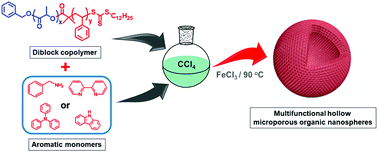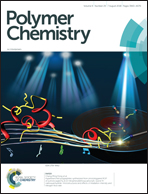Preparation of multifunctional hollow microporous organic nanospheres via a one-pot hyper-cross-linking mediated self-assembly strategy†
Abstract
Herein we report a universal method for the preparation of multifunctional hollow microporous organic nanospheres (H-MONs) using functional aromatic monomers (such as benzylamine, 2,2-bipyridine, triphenylamine or carbazole) and the polylactide-b-polystyrene (PLA-b-PS) diblock copolymer as precursors based on a one-pot hyper-cross-linking mediated self-assembly strategy. In this method, co-hyper-cross-linking among the PS block and various aromatic monomers forms the functional microporous organic shell frameworks, while the degradable PLA block produces the hollow core structure. By introducing functional organic ligands, various metal-loaded or heteroatom-doped H-MONs can be successfully synthesized. Owing to their high special surface area, robust organic framework, and hierarchically porous structure, these multifunctional H-MONs exhibited excellent catalytic activity or high adsorption capacity for radioactive iodine. The proposed one-pot strategy may provide a general approach to produce a variety of functional H-MONs for various applications in the future.



 Please wait while we load your content...
Please wait while we load your content...